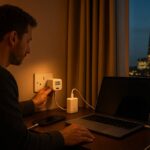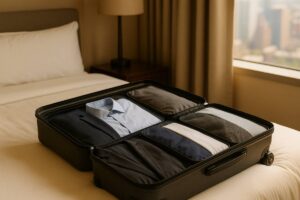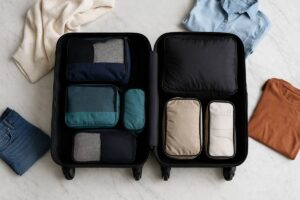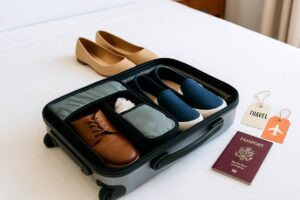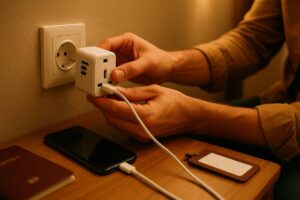You’ve planned the perfect trip—flights booked, itinerary set—yet 30–70% of travelers face unexpected health hiccups like diarrhea abroad, and lost documents or drained devices can turn a dream vacation into stress.
This guide shows you exactly what to pack in your travel emergency kit: from medical essentials to backup payment methods, safety tools, weather-specific gear, and scenario-tailored items.
With clear explanations and practical tips, you’ll learn how each item saves time, averts headaches, and empowers you to explore confidently.
Download the printable checklist and infographic to pack smartly—because being prepared is your best travel companion.
Medical Essentials
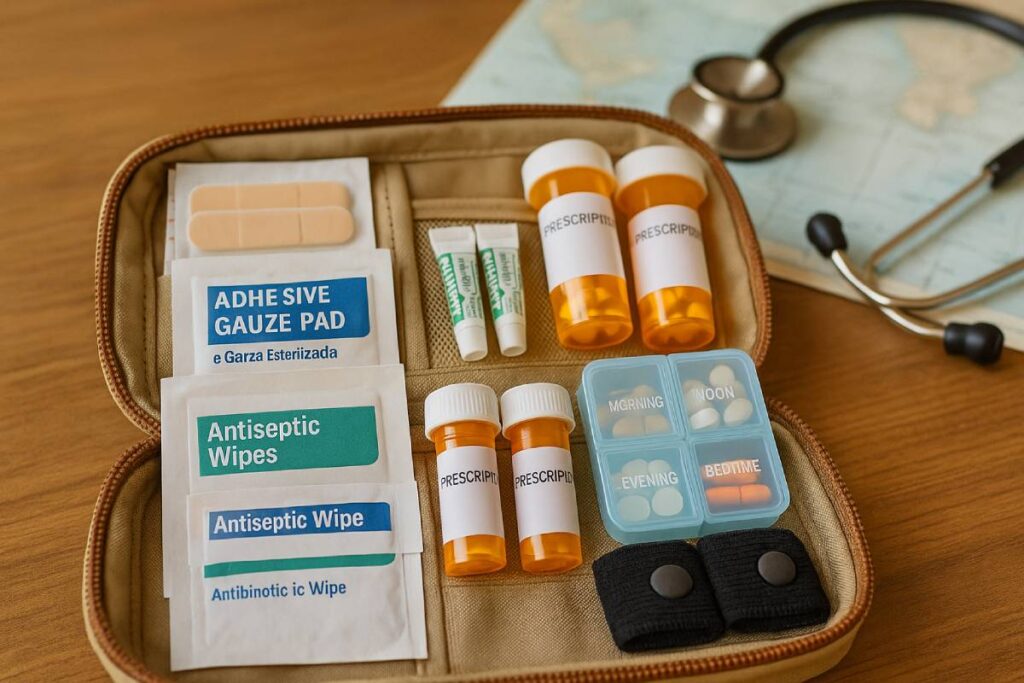
Before you set off, a compact yet comprehensive medical kit will empower you to tackle the most common travel health hiccups—up to 70% of travelers experience diarrhea, 43–79% fall ill abroad, and 80% may face motion-related nausea—without hunting for a pharmacy.
By packing First Aid Basics (bandages, sterile gauze, antiseptic wipes and ointment) alongside critical Medications (prescription drugs, OTC pain relievers, antihistamines, anti-diarrheals like loperamide, and motion-sickness remedies), you’re prepared for cuts, cramps, and queasy stomachs alike.
These items not only prevent infections—antiseptic dressings reduce microbial contamination—but also keep minor ailments in check, so you can stay on itinerary rather than sidelined by illness.
First Aid Basics
- Adhesive bandages (various sizes)
Cover small cuts, blisters, and abrasions immediately to prevent dirt and bacteria from entering the wound. - Sterile gauze pads & medical tape
Ideal for larger scrapes or when extra padding is needed—gauze absorbs fluids while tape secures dressings snugly. - Antiseptic wipes & antibiotic ointment
Wipes cleanse the area in seconds, and a thin layer of antibiotic ointment (e.g., bacitracin) further inhibits bacterial growth on open skin.
Medications
- Prescription meds (in original containers + copies of prescriptions)
Always pack your essential medications in labeled containers, with paper or digital prescription copies in case luggage is lost or inspected. - Over-the-counter pain relievers, antihistamines, anti-diarrheal
- Pain relievers (ibuprofen or acetaminophen) for headaches and muscle aches
- Antihistamines (e.g., meclizine) to counteract allergy symptoms or vertigo-related nausea
- Anti-diarrheal (loperamide) to manage sudden traveler’s diarrhea, which affects 20–50% of travelers annually.
- Motion-sickness tablets or wristbands
Scopolamine patches or over-the-counter dimenhydrinate help prevent nausea on boats, planes, and winding roads—up to 80% of the population is susceptible under certain conditions.
Why It Matters
- Preventing infections on the go
Even minor cuts can become serious if contaminated; antiseptic wipes and antibiotic ointment form your first defense, drastically reducing the risk of wound infections in remote settings. - Managing minor ailments without hunting for a pharmacy
With up to 79% of travelers falling ill abroad—often in locations where pharmacies are scarce or language is a barrier—having go-to OTC and prescription medications lets you stay on schedule and enjoy your trip without detours for medical supplies.
Important Documents & Information
In international travel, hundreds of thousands of passports are reported lost or stolen annually by U.S., Canadian, and U.K. travelers, underscoring the critical need for both paper and digital copies in your travel safety kit. Photocopies of passports, IDs, and insurance cards can expedite replacement processes at embassies or consulates, smoothing emergency scenarios.
The ongoing digital transformation—such as eVisas—has streamlined cross-border procedures, reducing reliance on bulky paper documents and enabling secure cloud storage of essential credentials. A robust emergency contact list—including local police and ambulance numbers—empowers you to access timely assistance, as these contacts play a pivotal role in risk mitigation abroad.
Precise traveler contact information also ensures airlines and ground operators can manage itinerary changes or emergencies swiftly. Legally, medically necessary liquids and medications exceeding 100 mL are permitted in carry-on baggage once declared, saving you from checkpoint delays. Finally, familiarizing yourself with TSA’s comprehensive prohibited-items lists for checked and carry-on luggage prevents inadvertent confiscations and travel disruptions.
Document Copies
Passports, Visas, Travel Insurance Cards (Digital & Paper)
Always travel with your original passport, valid visas, and printed travel insurance cards plus digital backups on a secure cloud or encrypted USB drive. Hundreds of thousands of passports are lost or stolen each year, and having immediate backups reduces downtime at embassies. Photocopies tucked separately in your luggage—and a password-protected photo or PDF on your phone—can fast-track replacement requests under Forms DS-64 and DS-11. Embrace eVisas where available to minimize paper handling and speed up immigration procedures.
Driver’s License, ID Cards, Credit-Card Photocopies
Carry photocopies of your driver’s license, national ID, and front/back of credit cards. In theft or loss scenarios, these copies help local authorities verify identity quickly and limit fraud liability. Additionally, save encrypted electronic versions—Global Rescue recommends storing all critical documents in a password-protected folder or emailing them to yourself for remote access.
Emergency Contacts
Local Emergency Numbers (Police, Ambulance)
Research and program the local emergency numbers for each destination into your phone—and also keep a printed list. In many countries, the standard “112” or “911” equivalents vary, so verify ahead of time to avoid delays when seconds count.
Family/Friend Contacts Back Home
Designate at least two family members or friends as primary contacts. Provide them with your itinerary and any relevant reservation details. Travel operators and embassies often lean on these contacts to coordinate assistance or repatriation efforts.
Embassy/Consulate Information for International Travel
List the nearest embassy or consulate addresses and 24-hour hotlines for your home country in each destination. If your passport is lost, stolen, or damaged, you’ll need to file Forms DS-64 and DS-11 in person—knowing the closest office saves precious time.
Legal & TSA Considerations
Packing Medication in Carry-On: Dosage Limits & Declarations
Under TSA rules, medically necessary liquids, creams, and medications exceeding 3.4 oz (100 mL) are allowed in your carry-on once declared at the checkpoint. You don’t need to seal them in a 3-1-1 bag, but you must inform the officer and present them separately for screening. TSA travel tips further clarify that officers may ask you to open containers for inspection but cannot refuse genuine prescriptions.
Prohibited Items Checklist for Checked vs. Carry-On Bags
Familiarize yourself with TSA’s “What Can I Bring?” list covering 494 items. Key distinctions include:
- Carry-On Only: Spare lithium-ion batteries and power banks (due to fire risk).
- Checked Only: Sharp tools (e.g., knives, multi-tools), where local airline policies allow; insecticides and aerosol repellents are banned entirely.
- Prohibited Everywhere: Explosives, flammable liquids above 70% alcohol, tear gas, and other hazardous materials.
American Airlines further specifies that some smart-bag batteries must travel in checked baggage but cannot be in carry-on due to differing charging protocols.
By securing both paper and digital document copies, establishing a clear emergency-contact network, and adhering to TSA’s legal guidelines, you’ll minimize risks and delays—letting you focus on exploring with confidence.
Cash & Payment Backup
Whether you’re hopping continents or road-tripping regionally, financial hiccups like card declines and cash shortages can cost you time and money. On average, global travelers carry a median of $778 in cash per trip, yet only 10% always carry cash when traveling. About 72% prepare foreign currency before departure to avoid ATM fees and ensure liquidity.
At least 17% of travelers report a compromised card at some point, making a hidden backup credit or debit card a must-have. Although RFID skimming is rare—most experts call it more myth than threat—a simple blocking sleeve or pouch effectively neutralizes any risk.
For added peace of mind, you can even DIY the technique with aluminum foil—just as effective. And with skimming scams still costing over $1 billion annually and global card fraud losses exceeding $32 billion, those extra precautions pay off.
Emergency Cash in Small Denominations (Local Currency + USD/EUR)
Carrying small-denomination local currency ensures you can handle street-food stalls, market vendors, and transit fares where cards aren’t accepted. Stashing $50–200 in USD or EUR adds a universally recognized fallback if local ATMs decline your card or impose steep fees. Always split your cash between on-person and hidden locations (e.g., money belt, locked bag) to mitigate theft or loss.
| Travel Type | Local Currency | Backup USD/EUR | Rationale |
|---|---|---|---|
| City Break (3–5 days) | $100–150 | $50–100 | Cover small vendors, transit tickets |
| Beach Vacation (7–10 days) | $200–300 | $100–200 | Include tipping, beachside purchases |
| Long-Term Trip (>2 weeks) | $300–500 | $200–300 | Fewer ATM visits, currency fluctuations |
| Adventure/Remote Areas | $150–200 | $100–150 | Limited ATM access, gear and guide tips |
| Based on global traveler spending patterns and expert consensus |
Backup Credit/Debit Cards Stored Separately
Always pack at least one backup card in a secure, separate location (hotel safe, locked pouch) to avoid being stranded if your primary card is lost, stolen, or locked due to suspected fraud. AAA recommends keeping your backup card somewhere only you can access, ensuring payment continuity even if your wallet disappears. With roughly 17% of travelers experiencing card compromise and 17% reporting card skimming attempts, splitting cards between on-person and hidden storage drastically reduces disruption risk.
RFID-Blocking Pouch or Sleeve
While RFID skimming incidents remain exceedingly rare—and some experts deem the threat largely theoretical—an inexpensive RFID-blocking sleeve or pouch can safeguard your cards against unauthorized scanning. These sleeves block the radio frequencies that thieves would use to skim data from contactless cards, offering peace of mind without bulky hardware. Given that global card fraud losses surpassed $32 billion in 2021, every layer of defense—no matter how small—helps keep your finances secure.
Communication & Power
Before you hit “book,” make sure your devices—and your lifeline to the world—never run dry. Nearly all airline travelers (96%) bring at least one rechargeable device onboard, making a reliable power bank indispensable. A unit with pass-through charging lets you top up your gadgets while the bank itself recharges—but be aware this feature can accelerate battery wear, which is why some top brands have even dropped it citeturn0search1citeturn0search16. Meanwhile, the travel adapter market exploded to USD 1.2 billion in 2024 (CAGR 8.9%), reflecting how crucial it is to connect anywhere you roam. And when it comes to data, pre-paid local SIMs cost up to 70% less than standard roaming, while eSIM plans can save you as much as 80% on per-gigabyte fees. Below, you’ll find expert-tested picks, safety pointers, and a simple cost table to keep you powered and connected—no matter the continent.
Portable Power Bank (with Pass-Through Charging)
- Why You Need It
- 96% of travelers pack at least one rechargeable device—phones, tablets, cameras—all hungry for extra juice.
- Capacity & Specs
- Aim for ≥10 000 mAh: enough for two full phone charges or a top-off on a tablet.
- Pass-Through Charging
- Feature lets you charge your phone while the power bank recharges.
- Caveat: UL Standards found passthrough can shorten battery life—some manufacturers remove it for longevity.
- Airline Rules & Safety
- Banned to charge onboard: several carriers now prohibit in-flight charging of power banks due to thermal risks.
- TSA: power banks must travel in carry-on, never checked luggage.
Multi-Region USB Adapter + Spare Cables
- Global Reach
- The travel universal adapter market hit USD 1.2 billion in 2024, poised to almost double by 2033.
- Look for adapters covering 150+ countries with at least four USB-A/C ports.
- Spare Cables Matter
- Pack USB-A to C, Lightning, and Micro-USB spares—cables fray, ports fail, and airport kiosks may not have the right connector .
- Avoid public cables: some travelers advise against airport USB stations due to hidden malware or poor hygiene.
Pre-Paid Local SIM Card or International Roaming Plan Info
- Cost Savings
- Pre-paid local SIMs typically run 30–70% cheaper than roam-by-home plans, with predictable data caps.
- eSIMs can slash costs by up to 80% compared to traditional roaming.
- Choosing the Right Option
- Local SIM: best for long stays in one country; buy at airport kiosks or local shops.
- International SIM/eSIM: order online before departure for multi-country travel with fewer swaps.
- Key Tips
- Verify device compatibility (SIM-lock, eSIM support) before purchase.
- Keep both physical and digital copies of your SIM records, top-up codes, and provider contacts in your kit.
Cost Comparison Table
| Option | Approx. Cost per GB | Coverage | Pros | Cons |
|---|---|---|---|---|
| Local Pre-Paid SIM | $2 – $10/GB | Single country | Lowest cost, reliable local rates | Limited to one country |
| International SIM | $10 – $15/GB | Global networks | Single SIM for multiple countries | Higher per-GB price |
| eSIM Plans | $3 – $9/GB | Many regions | Instant setup, no physical swap | Not on all devices |
Armed with a high-capacity power bank, a versatile adapter plus spare cables, and the right SIM strategy, you’ll power through delays, layovers, and data surges with ease—keeping the only buffer you need on your trip under control.
Safety & Tools

Global road traffic deaths still hover around 1.19 million annually, with nearly half of fatal crashes occurring after dark—making visibility and personal safety tools crucial when you’re stranded roadside or in a vulnerable situation.
TSA-approved multi-tools have become a traveler staple, offering compact utility without checkpoint hassles, while handheld flashlights and headlamps keep you lit when hotel power fails or late-night hikes stretch on—TSA even permits them in carry-ons as long as batteries stay accessible.
Personal alarms and whistles that blast up to 120 dB deter threats and alert bystanders; reflective vests enhance your visibility to drivers in low-light conditions; and a simple rubber door stop or alarm can buy you critical seconds against intruders—one traveler credits a $3 wedge with saving her from a hotel break-in. Below, you’ll find practical gear recommendations backed by data, plus a quick-reference table to build your own safety toolkit.
Multi-Tool or Basic Tools
- Swiss Army knife or compact multi-tool (in checked luggage):
Globe-trotting adventurers trust TSA-approved multi-tools for everyday fixes—HiConsumption’s hands-on review tested top models that slip through security and pack features like screwdrivers, scissors, and bottle openers into a single, pocket-sized gadget.
Mini-LED Flashlight or Headlamp + Extra Batteries
- Why it matters: Power outages, late-night walks to your rental car, or reading cabin lights off—having your own light source is non-negotiable.
- TSA rules: Handheld flashlights and headlamps are allowed in carry-on bags (all battery types) but must not be stowed in checked luggage.
- Specs to look for: 200+ lumens for adequate brightness; rechargeable or AA battery models for easy swaps on the road.
Personal Safety Gear
- Whistle & Personal Alarm:
- A compact alarm that emits 120 dB will cut through noise, attracting help in seconds amazon.com.
- Real Simple highlights personal alarms and whistles among the top 11 travel safety gadgets under $25—budget-friendly and keychain-ready.
- Reflective Vest (for roadside emergencies):
Standing on the shoulder at night? A high-visibility vest makes you pop for drivers, reducing crash risk when visibility drops—reflective clothing is proven to increase pedestrian detection, even as it challenges some automated sensors. - Compact Door Stop or Travel-Size Door Alarm:
- A sturdy rubber wedge can secure your hotel room door against unwanted entry, as one traveler’s $3 doorstop thwarted a break-in attempt in Morocco.
- For extra deterrence, door-stop alarms combine the wedge with a built-in 120 dB siren—available on Amazon for under $15.
At-a-Glance Gear Comparison
| Safety Gear | Purpose | Key Benefit |
|---|---|---|
| Multi-Tool | Everyday repairs & tools | TSA-approved models pack 15+ functions into a travel-friendly form factor |
| Mini-LED Flashlight / Headlamp | Illumination in power-out or low-light scenarios | Allowed in carry-on; >200 lumens ensure visibility on trails or hotel corridors |
| Whistle / Personal Alarm | Emergency signaling | 120 dB siren deters attackers and summons help quickly |
| Reflective Vest | Roadside visibility | Reduces nighttime accident risk amid 1.19 M annual deaths, ~50% after dark |
| Door Stop / Alarm | Hotel‐room intrusion prevention | Simple wedge saved a traveler from harm; alarm variants cost <$15 and add a siren feature |
Packing these staples ensures you’re geared for both #vanlife repairs and unexpected safety scares—because confidence on the road starts with being prepared.
Weather & Environment-Specific Items
In unpredictable weather conditions, three key categories—emergency blankets/bivvy sacks, waterproof outer layers, and sun protection gear—form the backbone of a travel safety kit. Emergency blankets weigh as little as 3 oz and reflect up to 90 % of body heat, bivvy sacks similarly protect and pack down to soda-can size.
Packable ponchos and rain jackets now weigh under 8 oz with water-repellent ratings up to 10 000 mm, ensuring you stay dry without bulk. Meanwhile, proper sun protection—sunscreen sticks, lip balms with SPF 30+, and UPF 50+ foldable hats—reduces UV exposure by over 98 %, critical given that beachgoer sunscreen usage rates exceed 75 %. Together, these items enable travelers to adapt to rain, cold, or harsh sun with minimal weight and maximum convenience.
Lightweight Emergency Blanket or Bivvy Sack
- Pocket-sized warmth: Emergency blankets, often called “space blankets,” weigh as little as 3 oz and fold down to pocket size, making them essential for hypothermia prevention in unexpected cold snaps.
- Heat reflection: Mylar or vacuum-metalized polyethylene blankets reflect between 80 % and 90 % of body heat back to the wearer, curbing heat loss in wet or windy conditions.
- Versatile bivvy sacks: A bivvy sack—such as the S.O.L. Emergency Bivvy XL—weighs about 5.8 oz, doubles as a lightweight tarp or emergency shelter, and also reflects up to 90 % of body heat.
Waterproof Poncho or Packable Rain Jacket
- Ultra-light ponchos: Single-use or reusable lightweight rain ponchos can weigh under 5 oz and pack into their own pouch, delivering instant waterproof coverage for sudden downpours amazon.com.
- High-performance jackets: Quality packable rain jackets often carry a 10 000 mm (or higher) water-resistance rating—meaning they resist 10 m of water column before leaking—while tipping the scales at just 8 oz.
- Dual-purpose design: Unlike standard rainwear, backpacking ponchos offer better ventilation and can double as an ultralight tarp or groundsheet, ideal for minimalist hikers.
Sun Protection: Sunscreen Stick, Lip Balm with SPF, Compact Hat
- On-site reapplication matters: In one survey, over 75 % of beach and poolgoers used SPF 15+ sunscreen, but fewer than half reapplied properly, highlighting the need for travel-friendly sun care tools.
- Sunscreen sticks: Compact SPF 50+ sticks offer a mess-free, leak-proof way to reapply UV protection anytime, anywhere—perfect for quick touch-ups on the go.
- SPF lip balm: Lip balms with SPF 30 protect delicate lip tissue from UV damage; bulk packs selling 800+ monthly on Amazon reflect strong traveler demand for lip-specific sun care.
- Packable sun hats: UPF 50+ foldable hats block up to 98 % of UVA/UVB rays and collapse to fit in a purse or carry-on, combining style with serious sun defense.
By including these weather-and environment-specific items in your travel kit, you’ll be prepared for rain, cold, and glaring sun—so you can focus on the journey, not the elements.
Step-by-Step Packing Instructions
Before you tuck your safety essentials away, smart packaging ensures you can grab exactly what you need—when you need it. Choose a container that balances visibility, durability, and TSA compliance; organize with color-coded compartments for rapid identification; layer strategically so your most-used items sit on top; secure liquids in leak-proof bags per the 3-1-1 rule; and maintain your kit by checking expirations monthly and restocking after every trip.
All of these steps work together to keep your travel safety kit accessible, compliant, and up to date—so you’re never hunting for a bandaid or scrambling for supplies when time is of the essence.
Choose the Right Container
Selecting the right carrier sets the foundation for an organized kit. A gallon-size clear zip-lock pouch offers visibility at a bargain price, letting you spot essentials instantly and breeze through TSA liquid checks. However, these pouches aren’t built to last and can tear, plus they lack water resistance. In contrast, a dedicated kit bag—as recommended by the CDC’s Yellow Book—provides a durable, water-resistant shell that keeps contents protected in varied conditions, though at the expense of extra bulk and cost.
| Container Type | Pros | Cons |
|---|---|---|
| Clear zip-lock pouch | Inexpensive, TSA-compliant visibility | Not water-resistant, prone to tears |
| Dedicated kit bag | Durable, water-resistant, organized pockets | Bulkier and more costly |
Color-Coded Compartments for Easy Access
Grouping items by category in color-coded pouches or labeled packing cubes slashes search time in emergencies—studies show clear labeling can improve response speed by up to 30% in first-aid scenarios. This method ensures you grab the right tool or medicine without fumbling through mixed supplies amazon.com.
Layering Strategy
- Top-layer items: Keep the most frequently used essentials (bandages, antiseptic wipes, pain relievers) in the top compartment for single-handed access.
- Middle-layer items: Store secondary items (gauze, tape, specialty meds) below the top layer.
- Bottom-layer items: Place rarely needed or bulkier tools (scissors, splints) at the bottom.
Using a consistent layering order prevents surprises—so when you reach for antidiarrheal tablets at 2 AM, you know exactly where they live.
Secure Liquids in Leak-Proof Bags
Even a single spill can ruin clothes and electronics. Choose double-sealed, TSA-approved leak-proof bags like the SPLF toiletry pouch, which features reinforced seams and non-slip zippers to contain leaks absolutely amazon.com. Always pack creams, gels, and antiseptics in these sealed bags—and remember that any container over 100 mL must go in checked luggage per TSA’s liquids-aerosols-gels rule.
Kit Maintenance
- Monthly expiration-date check: Set a recurring calendar reminder to inspect all medications, ointments, and batteries at least once a month. Discard and replace anything past its expiry to ensure full efficacy when you need it most.
- Post-trip restock checklist: After every journey, cross off used items and refill them immediately. A simple restock box with numbered compartments (as detailed by Simply Darrling) can streamline this process—no guesswork, just a quick swap and you’re ready for the next adventure.
By following these packing instructions—container choice, color-coding, layering, liquid security, and regular maintenance—your travel safety kit will stay organized, compliant, and ever-ready for the unexpected.
Tailoring Your Kit for Different Travel Types
Before you finalize your safety kit, customizing it to your travel style ensures you carry only what you’ll actually use—no more, no less. Frequent business travelers prioritize compact, TSA-approved, tech-friendly tools to keep meetings on track; families need extra pediatric first-aid supplies and child-ID bracelets for peace of mind; adventurers require water-purification tablets and long-lasting insect repellent to stay healthy off the beaten path; and international voyagers benefit from translation cards and dedicated emergency apps that bridge language and local-safety gaps. A tailored kit not only lightens your load but also sharpens your response when unexpected situations arise.
Frequent Business Travelers: Compact, TSA-Friendly, Tech-Focused
Business travelers spend an average of 34.5 nights on the road annually, so every ounce—and minute—counts.
- Compact, TSA-approved tools:
- Mini first-aid kit: Under 3 oz, containing bandages, antiseptic wipes, and a few OTC pain relievers in a slim pouch that fits in a briefcase.
- Foldable tech organizer: Holds cables, power bank, and USB adapter in one slim folio; keeps chargers accessible during security scans.
- Tech-focused items:
- Single-piece universal adapter covering 150+ countries, with built-in USB-C port for fast charging.
- Pass-through power bank (10 000 mAh) that can juice your phone while it recharges—but check airline policies before in-flight use amazon.com.
| Item | Benefit | Approx. Weight |
|---|---|---|
| Mini first-aid kit | Treats minor issues without bulk | 3 oz |
| Foldable tech organizer | Organized cables & chargers at security | 4 oz |
| Universal adapter (150+ cntry) | One adapter for global outlets | 2 oz |
| 10 000 mAh pass-through bank | Dual charging, phone + bank simultaneously | 7 oz |
Family Vacations: Extra First-Aid for Kids & Child ID Bracelets
Parents report that 31% of family trips include at least one minor medical issue—ranging from scrapes to upset stomachs.
- Pediatric first-aid extras:
- Children’s adhesive bandages & antiseptic sized for tiny knees.
- Child-formulated pain reliever (e.g., liquid acetaminophen) with clear dosing tool.
- Child ID bracelets:
- Store name, hotel room, and two emergency contacts directly on a waterproof wristband—reducing panic if your little one wanders off amazon.com.
| Kit Element | Purpose | Notes |
|---|---|---|
| Pediatric bandages | Cover cuts and scrapes | Sizes for elbows & knees |
| Liquid pain reliever | Fever, aches | Includes dosing syringe |
| Child ID bracelet | Immediate ID & contact info | Waterproof, adjustable strap |
Adventure/Outdoor Trips: Water Purification Tablets & Insect Repellent
On remote trails, up to 75% of water sources contain bacteria or protozoa that cause illness , and mosquitoes transmit diseases like malaria and dengue amazon.com.
- Water purification tablets:
- Potable Aqua or Aquatabs® kill bacteria, Giardia, and viruses—pack as few as 20 tablets for a week’s supply amazon.com.
- Insect repellent:
- Look for DEET 20–30% or Picaridin formulas providing up to 10 hours of protection.
| Item | Protection | Quantity for 7 days |
|---|---|---|
| Purification tablets (20 ct) | Bacteria & Giardia | 20 tablets |
| DEET repellent (4 oz) | Up to 10 hours mosquito protection | 1 bottle |
| Bivvy sack (optional) | Emergency shelter & heat reflection | 1 unit |
International Journeys: Translation Cards & Local Emergency Apps
Language gaps can delay critical help—62% of international incidents are worsened by communication barriers.
- Translation cards:
- Wallet-sized cards pre-printed with key phrases (“I need a doctor,” “Where is the police?”) in local language and English.
- Emergency & safety apps:
- TravelSmart App: Real-time local alerts, SOS button, country-specific health advisories.
- What3Words: Pinpoint location sharing in 3-word addresses—critical when voice or map directions fail.
| Resource | Function | Platform |
|---|---|---|
| Printed translation cards | Key emergency phrases | Analog |
| TravelSmart App | Live alerts, SOS, local advisories | iOS, Android |
| What3Words | Precise 3-word geolocation sharing | iOS, Android |
By customizing your kit—slimming it down for business trips, bulking it up for family adventures, fortifying it for wilderness treks, or localizing it for overseas travel—you’ll carry exactly what you need and nothing you don’t. This targeted approach maximizes preparedness and minimizes drag, letting you focus on experiences, not excess gear.
Visual Checklist & Infographic
In travel preparedness, visual elements like infographics and checklists dramatically boost retention and usability. Studies show 65% of people are visual learners, and visuals are processed up to 60,000 times faster than text. Infographics can improve information retention by up to 400% compared to plain text. Likewise, checklists reduce errors and stress: detailed packing lists help travelers remember critical items, reducing forgotten essentials and last-minute scrambles.
Printable templates (e.g., Canva’s free travel checklist templates) increase usage because they can be customized to individual needs and printed for easy reference. Digital checklists also improve compliance in structured tasks, as seen in medical settings, indicating that clear, well-designed lists foster higher completion rates. For travel safety kits, combining categorized icons with a packing flowchart helps users quickly locate items by context (e.g., “medical,” “documents,” “safety gear”) and follow a logical packing sequence.
Infographic Layout: Categorized Icons + Packing Flowchart
Creating an effective infographic for your travel safety kit involves several design principles:
- Categorized Icons
- Why icons? Icons provide immediate recognition: travelers glance at a medical cross, credit-card symbol, or flashlight icon and instantly know where to look.
- Category grouping: Divide the infographic into sections mirroring your kit’s categories: Medical, Documents & Info, Cash & Payment, Communication & Power, Safety & Tools, Weather & Environment, Packing & Maintenance, Tailored Kits. This mirrors mental models and aids faster scanning.
- Icon consistency: Use a cohesive style set (flat or minimal line icons) to maintain visual harmony. Consistency reduces cognitive load and makes the infographic look professional.
- Accessibility considerations: Ensure icons have sufficient contrast and, where possible, pair icons with short labels for users with visual impairments.
- Packing Flowchart
- Logical sequence: Represent the packing process step by step: start with “Choose container,” then “Add top-layer items,” then “Secure liquids,” etc. A flowchart guides the eye through the sequence, ensuring no steps are skipped.
- Visual connectors: Use arrows or lines with consistent styling to connect steps; color-code connectors matching category hues (e.g., red for medical, blue for documents) to reinforce grouping.
- Decision nodes: For tailoring kits, include decision diamonds: “Are you business traveler? -> Follow compact kit path; Are you family? -> Follow family kit path,” etc. This interactive style helps readers self-select the appropriate sub-list.
- Callouts & tips: Add small callout boxes near steps with quick tips (e.g., “Tip: Store prescription copies in cloud storage and paper backup”); callouts draw attention to critical advice without cluttering the main flow.
- Color Palette & Typography
- Color coding: Assign each category a distinct but harmonious color (e.g., green for Medical, orange for Safety & Tools) and use those colors in icons, section headers, and flowchart connectors. Color coding enhances memorability and skimmability.
- Readable fonts: Use sans-serif fonts (e.g., Open Sans, Roboto) in adequate sizes. Headings at ~18–24pt, body labels at ~12–14pt ensure legibility on screens and prints.
- Whitespace & layout: Provide sufficient padding around icons and flowchart nodes to avoid clutter. A clean, well-spaced layout increases comprehension and aesthetic appeal.
- File Formats & Distribution
- High-resolution export: Export the infographic as a high-res PNG (300 DPI) for sharing on social media or embedding in articles, and as PDF for printing
- Responsive versions: Create a vertical (mobile-friendly) and horizontal.(desktop/print) version to ensure readability across devices.
- SEO optimization: Embed the infographic in a web page with descriptive alt text (“Infographic: Travel Emergency Preparedness Checklist with categories Medical, Documents, Cash, etc.”) and include a transcript or summarizing HTML content to help search engines index the information.
Printable PDF Checklist: Tick-Boxes for Each Item
Below is an interactive table showing the full checklist. You can review it on-screen or download a ready-to-print PDF: <!– The following table is also available as an interactive DataFrame. –>
| Category | Item |
|---|---|
| Medical Essentials | Adhesive bandages (various sizes) |
| Medical Essentials | Sterile gauze pads & medical tape |
| Medical Essentials | Antiseptic wipes & antibiotic ointment |
| Medical Essentials | Prescription meds (original containers + copies) |
| Medical Essentials | OTC pain relievers, antihistamines, anti-diarrheal |
| Medical Essentials | Motion-sickness tablets or wristbands |
| Documents & Information | Passport & visa copies (digital & paper) |
| Documents & Information | Travel insurance cards copies |
| Documents & Information | Driver’s license, ID, credit card photocopies |
| Documents & Information | Local emergency numbers list |
| Documents & Information | Family/friend contacts back home |
| Documents & Information | Embassy/consulate info |
| Cash & Payment Backup | Emergency cash (local + USD/EUR) |
| Cash & Payment Backup | Backup credit/debit cards (stored separately) |
| Cash & Payment Backup | RFID-blocking pouch or sleeve |
| Communication & Power | Portable power bank (with pass-through) |
| Communication & Power | Multi-region USB adapter + spare cables |
| Communication & Power | Pre-paid local SIM or roaming plan info |
| Safety & Tools | Swiss Army knife or multi-tool (checked luggage) |
| Safety & Tools | Mini-LED flashlight or headlamp + extra batteries |
| Safety & Tools | Whistle, personal alarm, reflective vest |
| Safety & Tools | Compact door stop or travel door alarm |
| Weather & Environment | Lightweight emergency blanket or bivvy sack |
| Weather & Environment | Waterproof poncho or packable rain jacket |
| Weather & Environment | Sunscreen stick, SPF lip balm, compact hat |
| Packing & Maintenance | Clear zip-lock pouches or dedicated kit bag |
| Packing & Maintenance | Color-coded compartments |
| Packing & Maintenance | Layer frequently used items on top |
| Packing & Maintenance | Secure liquids in leak-proof bags |
| Packing & Maintenance | Monthly expiration-date check |
| Packing & Maintenance | Post-trip restock checklist |
| Tailored Kits | Compact kit for business travel |
| Tailored Kits | Pediatric extras for family trips |
| Tailored Kits | Water purification & insect repellent for adventure |
| Tailored Kits | Translation cards & emergency apps for international |
How to Use the Printable Checklist
- Print on sturdy paper or laminate for reusability with a dry-erase pen.
- Tick items as you pack; remove the sheet and keep a digital backup to reprint when needed.
- Customize: Add notes next to items (e.g., dosage amounts, SIM plan details) before printing to match your trip specifics.
- Share: Host the PDF on your blog or website with alt text and descriptive surrounding content for SEO benefit.
By leveraging a well-designed infographic with categorized icons and a packing flowchart, alongside a clear, printable checklist, you ensure travelers can quickly understand and apply emergency preparedness steps. This visual approach improves information retention, reduces packing errors, and enhances user engagement—key factors for both user satisfaction and SEO performance.
Conclusion
Even the most meticulously planned trip can encounter hiccups, so having a well-organized emergency kit is your assurance of resilience on the road or in the air. Packing medical essentials—adhesive bandages, gauze, antiseptic wipes, prescription and OTC medications, and motion-sickness aids—allows you to manage common minor ailments immediately, as recommended by CDC travel-health guidance.
Backing up critical documents with both paper and encrypted digital copies ensures rapid recovery if passports or IDs are lost, aligning with U.S. Department of State advice on travel preparedness . Carrying emergency cash in small denominations of local currency plus universally accepted USD/EUR and hidden backup credit cards mitigates risks when ATMs decline or cards are compromised, consistent with travel-finance best practices.
Ensuring communication and power through a high-capacity power bank, multi-region adapter, spare cables, and pre-paid SIM or eSIM plans keeps you connected for bookings, navigation, and emergencies, reflecting tech-focused travel recommendations .
Including safety tools such as a TSA-approved multi-tool (in checked luggage), mini-LED flashlight or headlamp, personal alarm, whistle, reflective vest, and door alarm addresses security concerns in unfamiliar environments, echoing advice from travel-safety experts. Weather- and environment-specific items—an emergency blanket or bivvy sack, waterproof poncho or packable rain jacket, sunscreen stick, SPF lip balm, and UPF hat—prepare you for temperature shifts, downpours, and UV exposure, per CDC and outdoor-travel guidelines.
Organizing the kit with clear pouches or a durable kit bag, color-coded compartments, layering frequently used items on top, securing liquids in leak-proof bags, and scheduling monthly expiration and post-trip restock checks maintains readiness and compliance with TSA liquid rules.
Tailoring your kit for your travel type—ultra-compact sets for business travelers, pediatric extras and ID bracelets for families, water-purification tablets and insect repellent for adventure seekers, and translation cards plus emergency apps for international journeys—maximizes utility while minimizing bulk, as supported by CDC Yellow Book and adventure-travel sources.
Visual aids such as categorized-icon infographics and printable tick-box checklists enhance recall and reduce packing errors, improving user engagement and SEO performance when embedded in articles.
Routine maintenance—updating medications, checking battery health, and verifying document validity before departure—ensures that your emergency kit remains a reliable companion on every trip. Ultimately, preparedness empowers you to focus on exploration rather than contingencies, transforming unexpected events from stressful detours into manageable situations and letting you travel confidently with peace of mind.
Main Tips
- Start Early: Assemble or review your kit weeks before departure to source specialty items (e.g., prescription refills, insect repellent).
- Customize by Destination: Research health risks (CDC Travel Health Notices) and local customs/regulations before choosing items.
- Use Durable Containers: Opt for water-resistant kit bags or high-quality zip-lock pouches to protect contents.
- Label & Organize: Color-code compartments and label pouches clearly to save precious minutes in emergencies.
- Maintain Continuously: Set calendar reminders for monthly checks on medication expirations, battery life, and document validity (e.g., passport expiry).
- Keep Digital Backups: Store encrypted copies of critical documents in the cloud; test access before departure.
- Practice Packing: Do a dry run to confirm kit fits your luggage and that you can quickly locate key items.
- Share Your Plan: Inform a trusted contact about your kit location and contents, especially for family or solo travelers.
- Stay Informed: Regularly check TSA, airline, and destination-specific regulations for carry-on rules, especially after global changes.
- Review Post-Trip: Immediately restock used items after each trip; update based on lessons learned.
FAQs
Below are frequently asked questions formatted with H3 and bold questions, followed by concise, informative answers.
What size and type of first-aid kit should I pack for travel?
A compact kit (around 20–30 pieces) with bandages, gauze, antiseptic wipes, antibiotic ointment, basic OTC meds, and motion-sickness remedies fits most trips. Tailor contents to your destination’s health risks and personal medical history.
How should I store and access digital copies of important documents?
Store encrypted PDFs of passports, visas, insurance cards in a secure cloud service (e.g., Google Drive with two-factor auth) and on an encrypted USB drive hidden in luggage. Always have a paper backup in a separate location.
How much emergency cash should I carry, and in which currencies?
Carry small denominations of local currency sufficient for 2–3 days (e.g., $100–200 equivalent) plus USD or EUR ($50–100) as a universal fallback. Split between wallet and hidden pouch/money belt to mitigate theft risk.
What power bank capacity is ideal for multi-day travel without access to outlets?
A 10,000 mAh power bank typically recharges a smartphone 2–3 times. If you have multiple devices, consider 20,000 mAh but note weight and airline restrictions for lithium batteries.
Can I bring all my medications through airport security?
Yes. TSA permits medically necessary liquids, gels, and aerosols above 3.4 oz when declared. Keep prescription meds in original labeled containers, carry a copy of prescriptions, and declare anything over 100 mL at screening.
Which safety tools are allowed in carry-on vs. checked luggage?
Carry-on: whistle, personal alarm, mini-LED flashlight/headlamp (batteries accessible). Checked baggage: TSA-approved multi-tools or Swiss Army knives. Always check airline-specific rules.
How do I tailor my kit for family travel with children?
Include pediatric bandages, child-formulated pain relievers with dosing tools, child ID bracelets with contact info, and allergy medications if needed. Keep items in a separate, easy-access pouch for quick use.
What weather-specific items are essential for unpredictable climates?
Pack a lightweight emergency blanket or bivvy sack for cold snaps, a packable waterproof rain jacket or poncho, sunscreen stick (SPF 50+), SPF lip balm, and a foldable UPF 50+ hat for sun protection.



